Ground based photos of the International Space Station
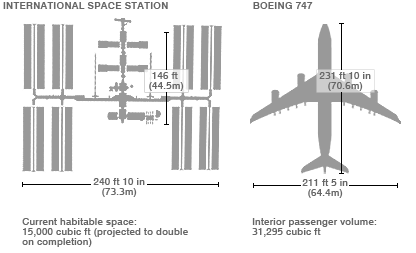
Here is a comparison to the apparent size of the ISS in a very high pass with Jupiter. Photo by Ralf Vandebergh
http://www.cloudynights.com/ubbthreads/attachments/3984678-JUP_ISS_100814a.jpg
Now that I've started getting good results, I'm starting a new page separate from my early attempts.
Equipment
Celestron CPC 1100 f10 telescope
Gateway 1.3 Ghz computer for tracking
1.6 Ghz dual core computer for imaging
Sat Tracker software
Wireless joystick
Imaging Source DFK 41AU02 Camera
April 22, 2009
My best results yet! I even had a chance to focus some and change the exposure during the pass. I shot this one at 1/500 second exposure, 15 fps. There was a lot of vibration in the movement of the telescope which caused blurring. I got over 100 frames with the entire ISS that weren't blurred. I centered the images by hand, the program degraded the images too much. The range at closest approach was 485 km, or about 303 miles. Photos are stacked results from several frames.
Photo processed by Freddy Willems - stacked from about 100 frames and sharpened.
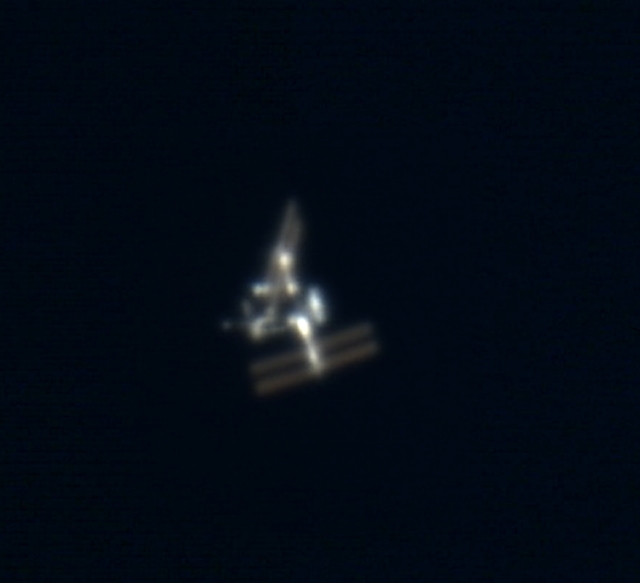
This video shows every frame that has any part of the ISS in it. As you can see, I was tracking pretty well and lost it. It took me quite a while to get it acquired again. The actual video is 3:31 long.
The frames from closest approach with the ISS centered.
The video includes 103 of the best frames, running at 5 fps.
September 3, 2009
I had a good pass of the ISS this morning, and the Space Shuttle is docked to it. They must have done an adjustment to the orbit, because the telescope tracking was so far off that the ISS wasn't even in the field of the finder scope. I quickly loosened the clutches and tracked manually, using the red dot scope and occasionally the regular finder scope. I got an image on ten frames. All frames are represented in the photo below. The exposure was very good, the focus was off just a bit. Closest approach was 220 miles.
November 28, 2009
I almost didn't get this pass. I used Jupiter to focus my telescope. I was moving the telescope to Vega to check the alignment of my finder scope when the telescope lost it's alignment. I did a quick alignment with Jupiter and moved to Vega to improve the alignment. The ISS was already about 15 degrees elevation when I got it going again. It was only 43.8 degrees elevation at it's highest point. That makes it easier to track, but it is much further away. It was 300 miles away at closest approach.
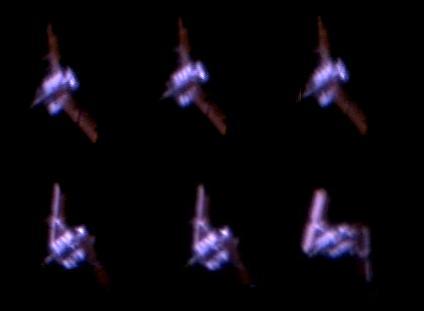
Video of the good frames, with the ISS manually centered in each frame. The entire 640 x 480 frames are used.
The same frames processed with RegiStax 5, automatic centering of the ISS. It uses only a portion of each frame.
March 18, 2010
This is my first pass with my new camera. Maximum elevation was just under 48 degrees and closest approach was 285 miles. It was easier to track - the telescope kept it on the chip for most of the pass until I started adjusting it. The larger chip really helped.
Here's a video of it
And a shorter video with just the sharpest frames
April 28, 2010
This was a tough one. The ISS was hidden by a tree for much of the pass and it also passed near the north celestial pole, which is hard with my polar aligned mount. Worse yet, it went into the Earth's shadow just 40 seconds after the closest approach. The images were a bit underexposed, making the solar panels invisible, or nearly so.
Here's the video, but it lost a lot of detail in the processing and conversion.
June 25, 2010
This was a 50 degree pass, and the closest approach was 460 miles, but it may be my best results so far!
It's hard to see, but each photo above shows a slightly different view - the ISS looks as if it's rotating, due to it's motion across the sky. You will be able to see this much more clearly in the videos below.
The best part of the pass, at actual speed
The best part of the pass, sped up
June 25, 2010
This was the second pass I had that day. I had more trouble tracking it, so I didn't have as good results. The exposure was also off a bit - the central portion was very bight and the solar panels weren't reflecting a lot of light in my direction. Also, the atmosphere conditions were bad. Enough of my excuses!
July 6, 2010
This entry is of something different. It is the United States Air Force's secret unmanned space shuttle. It is only 1/4 the Space Shuttle's size. I didn't get any detail. I clearly need a longer focal length. It wasn't visible to my naked eye when I looked up, but it wasn't very long before sunrise, so the sky had already started to brighten.

This video is sped up 4 times normal speed.
August 25, 2010
This pass was just about perfect for my location. The ISS rose in the southwest, where no trees blocked it, passed by me to my south, so the mount didn't have to deal with the North Celestial Pole and it set in the northeast.
Here's a video from the pass, sped up 4X
Here's the full frame raw AVI video - blank frames were cut out. It's 1.7 Gb in size.
And here is the best part of the past, using the best frames only.
August 27, 2010
Video of the best frames
Here's a montage of some of my best photos
May 4, 2011
It's been a long winter!
As usual, I had trouble tracking. I has the exposure off for a large part of the pass, and lost tracking at the closest portion of the pass. At the beginning of the video, you can see that I captured a "flare". The sunlight reflected off of the solar panels directly at me.
I have decided to make another upgrade. I have been using Satellite Tracker to track the ISS, and IC Capture to record the video. I am now upgrading to Optic Tracker Professional. It's pretty expensive, but I have a lot of money invested in my telescope, camera and observatory. It doesn't make sense to get haphazard results. Optic Tracker uses the main camera and a camera on a finder scope to track the ISS. I won't have another pass until later in the month to test it.
August 12, 2011
A great pass. My scope tracking was too far off. I tracked manually. I only got the ISS on a few frames.
I tweaked the brightness levels with Photoshop's "Curves" tool.
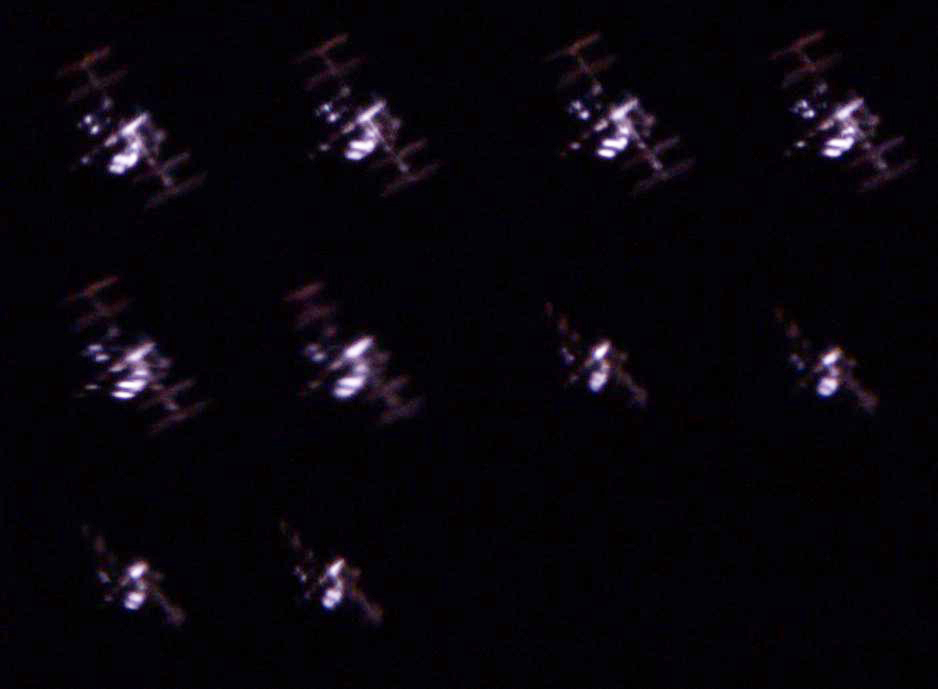
June 6, 2012
A great pass, 79 degrees elevation. It's been a long, long time since I got good results.
June 7, 2012
A lower pass, only 36 degrees maximum elevation. I had to wait for it to come out from behind the tree south of me.
June 10, 2012
I learned a valuable lesson tonight. I learned not to turn the gamma setting up.
Video speed is twice actual speed.
June 19, 2012
This was a fairly good pass. My neighbors' trees weren't in the way. It happened right before midnight, so the lighting was a bit different. It disappeared into the Earth's shadow before closest approach, though.
The video is at twice the actual speed.
June 22, 2012
A high pass - 79 degrees elevation.

June 25, 2012
A near perfect pass. Unfortunately, when I started my video recording, the program didn't work. I missed much of the pass getting it going.
I still got some good photos and video, though.
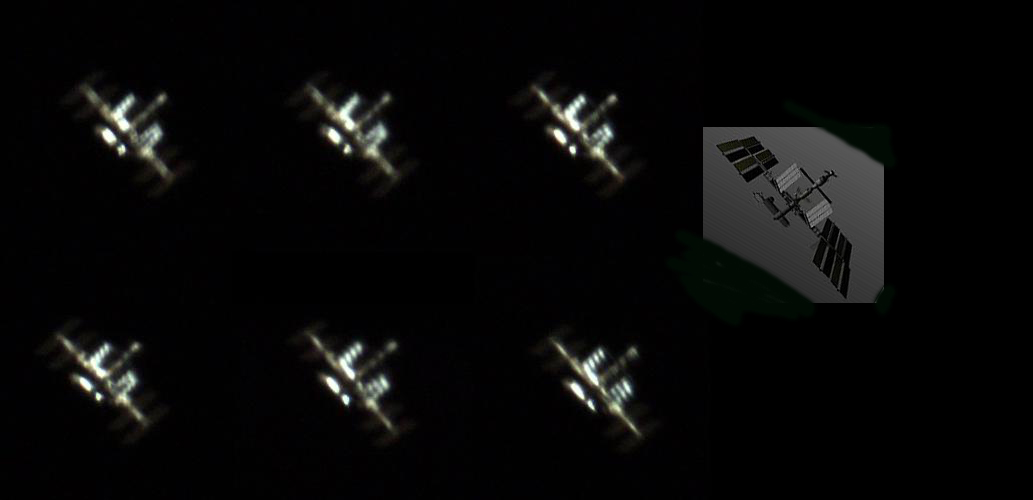
I tried to match my photos up with a virtual 3D model.
June 28, 2012
I have decided to try some daytime passes of the ISS. This pass was about an hour before sunset. I couldn't see it on the first half of the pass. I had to wait until I saw the sunlit side. It was still a pretty good pass. The solar panels become visible as the angle changes.
July 21, 2012
Not a good pass. 50 degrees maximum elevation, and it didn't come out of the shadow until around closest approach.
August 6, 2012
This was a good pass. I had some trouble with exposure and focus. There are the best frames from the video
November 15, 2012
It didn't come out of the shadow until it reached 55 degrees elevation. I tracked it for a bit, but lost it. I only got 32 frames with the ISS on it.

June 20, 2013
I had trouble tracking. The exposure was challenging, too. I tweaked the photos in Photoshop to bring out the solar panels.
April 22, 2014
Tracking was near perfect, exposure was off somewhat. Seeing was bad.
December 26, 2014
This was a strange one. There were thin clouds, so we weren't sure how well we would be able to see it. The computer started tracking it, but we couldn't see anything. When it got about 2/3 of the way across the sky, it backed up and caught the ISS high in the sky. Not only that, but it centered it pretty well and tracked it near perfectly. I have never seen anything like it.
I turned the gain up very high in order to use my focusing mask. I forgot to turn it back down, which is why the background sky has so much noise in it. It probably would have been seriously underexposed if I hadn't done so, since my exposure was about four times longer than I usually use. Any slower and the images would have been blurred.
I tried stacking some frames, but even the frames over a 3 or 4 second period show rotation of the ISS
The original frame rate was 7.5 fps
July 30, 2015
October 5, 2015
October 22, 2015
May 26, 2016
Just about everything that could go wrong, did, but I still got pretty good results. I went out about 20 minutes before the pass. The telescope was out of alignment, the finder scope was out of alignment with the scope, it was hazy and the tree west of me blocked the view until it was very high in the sky. In my hurry, I didn't check my exposure and for some reason, I had the gain set way too high, which is why it looks so grainy.
June 9, 2016
This wasn't a great pass. It passed south of me, which is good because it avoided the trees west of me, but only 40 degrees or so in altitude. This is my first observation since I removed the infrared filter from my camera. My hope is that it will allow sharper photos.
When looking at the raw video, I see the sharpness come and go on a pretty regular way. Opening my roof earlier would probably help by allowing the scope to cool down better. The passes this month are all early in the morning.
September 7, 2016
This pass was pretty difficult for me. The beginning of it was blocked by large trees west of me. It is best to get the computer tracking locked in while it is low in the sky and it's apparent motion is slower. Also, it passed near the north celestial pole, so my telescope stops tracking, spins about 180 degrees and then restarts tracking. This made my window for successful tracking pretty narrow. Even with this, I had pretty good results.
September 21,2016
I had trouble tracking this pass. I would get it centered, and the telescope would immediately move away from it.
October 17, 2016
This was a great pass. The tracking was very good, too. I got a nice, long video. I remember when I felt lucky to get 5 or 10 frames with the ISS on them. Tonight I got 6,415. Amazing
I didn't realize it has been so long since I have posted any photos or videos! Recently, I have been watching it fly over through an eyepiece. It is AMAZING the detail that can be seen this way!
In any case, I may try some photography again.
Here is a montage with a photo from every pass I have gotten results from so far
December 9, 2020
It's been a long time since I did any photography. I've been watching it through an eyepiece. I decided to give it another shot and was pleasantly surprised.
It was a good pass - 80 degrees maximum elevation. I didn't do so good with the tracking - I got only 70 frames. Here is a representative frame.
June 28, 2021
A near perfect pass today. My tracking was off, so I hand guided and got a few frames.
I
June 27, 2022
A near perfect pass, at 86 degrees elevation at it's highest. Unfortunately it was partly cloudy.
I guided by hand, having given up on computer programs for the time being
I am using a 3X-9X rifle scope with illuminated crosshairs
I used a focal reducer on my telescope, so it is f6.3 instead in f10. It is easier to get the ISS in the frame, but it is also smaller
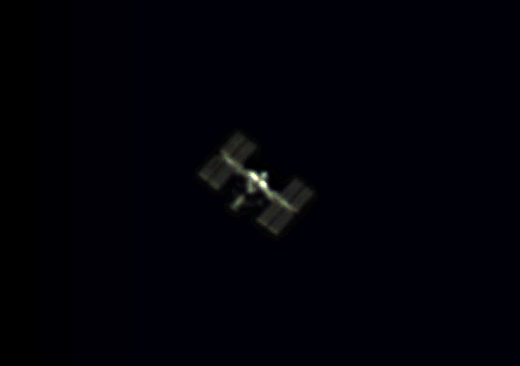
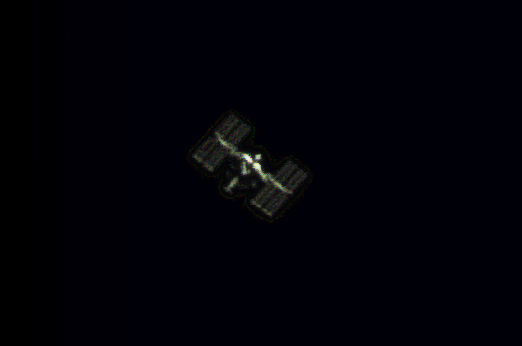
July 13, 2022
A near perfect pass, at 81 degrees elevation at it's highest.
Back to full focal length, f10

My photo on the left, a 3D representation on the right
September
5, 2024
After a long dry spell, finally some good results.
The CSS rose in the west just one minute before the ISS rose in the northwest.
The ISS pass was an 87 degree pass.
I tracked manually, first the CSS and when the ISS got up high enough to see I switched to the ISS
Other peoples' results